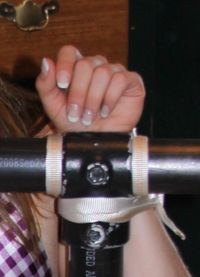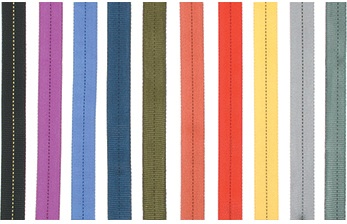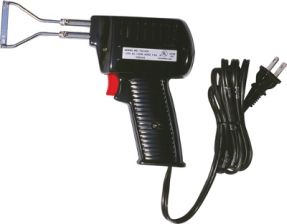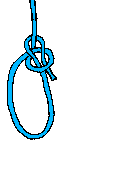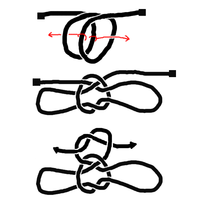Tubular webbing
Webbing
- I first bumped into webbing while I was involved in rock climbing in the '60s. I, personally, enjoy using tubular webbing in sessions. /Robin
Webbing is a strong fabric woven as a flat strip or tube of varying width and fibers often used in place of rope. It is a versatile component used in climbing, furniture manufacturing, automobile safety, auto racing, towing, parachuting, military apparel, and many other fields. Modern webbing is often made from exceptionally high-strength material, such as Dyneema, Nylon, Polyester, and Kevlar. For less performance-oriented applications Cotton, Polypropylene, and flax can be used. As webbing is both light and strong, with breaking strengths in excess of 10,000 lb (44.4 kN) readily available, the possible applications are virtually limitless.
It comes in quite a few sizes (1/2", 9/16", 5/8" 1", 1 1/2", and 2") and a wide range of colors.
To keep the ends of the webbing from fraying, it is best to heat the end of the webbing to seal it. There are several ways of sealing the ends, but the best way is to cut and seal the ends in one operation using the cutter shown at right. If you don't have a cutter, cut the webbing with shears and then seal the ends with a candle. (Using matches will often transfer the sulfur smell to the webbing, and since they don't burn very long, they tend to burn fingers!)
In my opinion, there are four major advantages to using webbing.
- It can be easily cleaned in a washing machine.
- Being a bondage photographer, I can color coordinate my bondage. (I can match or contrast the color of her skin, hair, dress, etc.)
- Since it lays flat, you don't get those funny little "snake marks" on the skin like you do when using a rope.
- It easily rolls up and lays flat so it will fit in my trouser pocket. It goes through airport metal detectors without setting off any alarms.
Toy bag
I recommend buying three pieces of red, black, and white webbing 1/2" or 9/16" wide and fifty feet long, but of course your mileage may vary. I would then cut two of the fifty-foot section as follows: four pieces of three feet; four pieces of five feet; and two pieces of nine feet. The third piece I would cut into two pieces of seven feet; and three pieces of twelve feet each.
Once you have cut them into the lengths shown above, you can tie them into hanks, or use rubber bands to hold the hanks together. Since two of the colors were cut to the same size, and you can see the overall size of each hank, you can grab the right length the first time and every time. (You would never want your play partner to see you fumbling around in your toy bag looking for the right piece of webbing!)
After each use (as I said above) throw it in the washing machine, re-tie the pieces into hanks. This will mean that everything in your toy bag will always be clean and ready for use.
A funny story
In the late 1980's I was 'commuting' from Carson City to San Jose on a twice a week basis. On one of those trips, a pickup truck was pulling a livestock trailer when the trailer disconnected and rolled over on Highway 580 near Livermore, California. Suddenly, there were six cows running around on the freeway. I came to a stop and surveyed the sight of these cows wandering up and down the freeway.
I opened my trunk and grab a couple of pieces of webbing. I tie handcuff knots in each of them, and, one at a time, slip the webbing over the horns of the cows and tie them to the chain-link fence.
A few minutes later, a Highway Patrol officer arrives on the scene to take an accident report. He sees the cows and says,
- "That was a really great idea. What is that stuff?"
- "Tubular webbing, Officer."
- " And what do you use it for?"
- "Well, Sir, I use it to tie up girls!"
- "Yeah, RIGHT!", he responds.
The farmer and a batch of onlookers tip the trailer back on its wheels, and we loaded the cows back into the trailer. Several of the people present, including the CHP officer, asked if they could have sample pieces of webbing that I had used. How could I refuse?
There are so many, many knots available to us all. There are three specific knots that I will talk about here.
This knot can tie two ropes or two ends of a rope together.
This knot is used to tie a non-slip loop on the end of a rope
I think the usage of this handcuff knot is self-explanatory
The name of the game is "Bondage and Discipline", not "Cuffs and Discipline". Bondage is an elemental part of B&D sessions. If you are insecure about your knot-tying abilities, your client will definitely notice it.
These three knots above should be considered 'bare minimum requirements' for anyone wishing to do sessions. For safety reasons, you should also be able to tie and untie them in the dark.
See also Curricula and/or Rope and Knot terms

|
This article is about either
|
What links here • References and Sources • Contact info • Category:Root ⤴
Chat rooms • What links here • Copyright info • Contact information • Category:Root
